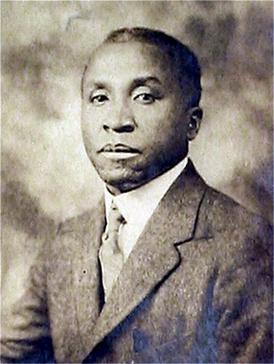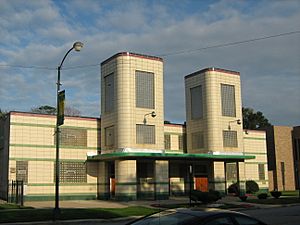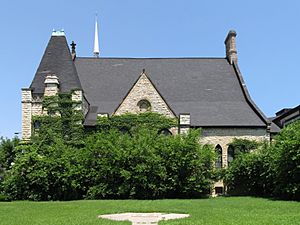Walter T. Bailey facts for kids
Quick facts for kids
Walter T. Bailey
|
|
|---|---|
 |
|
| Born | January 11, 1882 |
| Died | February 21, 1941 (aged 59) |
| Nationality | American |
| Occupation | Architect |
| Buildings | Woodmen of Union Bath House First Church of Deliverance |
Walter Thomas Bailey (born January 11, 1882 – died February 21, 1941) was an amazing American architect from Kewanee, Illinois. He made history as the first African American to earn a special degree in architectural engineering from the University of Illinois at Urbana-Champaign. He was also the very first licensed African-American architect in Illinois. He designed buildings at the Tuskegee Institute and worked in cities like Memphis and Chicago.
Contents
Early Life and Learning
Walter Thomas Bailey was born on January 11, 1882, in Kewanee, Illinois. He went to Kewanee High School there. In 1900, he started studying at the University of Illinois at Urbana-Champaign.
Walter Bailey was the first African-American person to graduate from the University of Illinois' School of Architecture. He earned his Bachelor of Science degree in architectural engineering in 1904. Later, in 1910, the university gave him an honorary master's degree in architecture. On October 15, 1905, Walter Bailey married Josephine L. McCurdy. They had two daughters, Edith Hazel, born in 1905, and another daughter also named Edith Hazel, born in 1913.
Designing Buildings: Walter's Career
Walter T. Bailey was the first licensed African-American architect in the state of Illinois. After he graduated, he first worked for a small architecture company owned by Henry Eckland in his hometown of Kewanee. He also worked for another company called Spencer & Temple in Champaign, Illinois. During this time, he helped plan the Colonel Wolfe School in Champaign in 1905.
Working at Tuskegee Institute
In 1905, Walter Bailey became the head of the Mechanical Industries Department at the Tuskegee Institute. While he was there, he designed several buildings on the campus. These included White Hall in 1908 and a dormitory for girls. He stayed at Tuskegee until 1916.
Moving to Memphis and Chicago
After leaving Tuskegee, Walter Bailey moved to Memphis. He opened his own architecture business on Beale Street. In Memphis, he started working on projects for the Knights of Pythias, a fraternal organization.
He designed the Mosaic State Temple Building and the Pythian Theater Building in Little Rock in 1922. The next year, he worked on another project in Arkansas. This was the Pythian Bath House and Sanitarium in Hot Springs. This special building was made just for African Americans to use.
Through his connections with the Knights of Pythias, Walter Bailey got the biggest project of his career. This was the National Knights of Pythias Temple in Chicago, Illinois. Construction on this huge building started in 1924, and Bailey moved his office to Chicago. The National Pythian Temple cost a lot of money to build. It was located in an area of Chicago known as "Bronzeville" or "Black Metropolis."
Walter Bailey first rented an office on the second floor of the Overton Hygienic Building on South State Street. The building was planned to be the main office for the Knights of Pythias. It would have many meeting rooms, stores, and offices to rent out. Walter Bailey designed cool terra-cotta griffins (mythical creatures) for the outside of the temple. Even though the Knights of Pythias later lost ownership of the building, Bailey kept his office there after it was finished. Sadly, the Knights of Pythias Temple was taken down in 1980. However, a large decorative piece from the building, an Egyptian pharaoh made of glazed terra cotta, is now kept at the Art Institute of Chicago. This piece was probably designed by Bailey to celebrate black pride.
Later Projects
Besides the Knights of Pythias Temple, Walter Bailey didn't have many other big projects in the 1920s. The Great Depression, a time when the economy was very bad, made it hard for many businesses, including his.
His last major project was the Chicago Landmark First Church of Deliverance in 1939. This church was designed in the Art Moderne style. This style uses strong horizontal lines and large glass windows. Walter Bailey added lines of green terra-cotta blocks to the front of the church. The building was used as both a church and a radio station for Reverend Clarence Cobbs to broadcast his sermons.
Walter Bailey's Passing

Walter T. Bailey passed away on February 21, 1941. He died from pneumonia and problems with his heart. News reports at the time said he was working on two projects when he died. One was the Olivet Baptist Church. The other was reportedly the Ida B. Wells Homes, but he was likely helping with that project in a smaller way.
Some of Walter Bailey's Designs
Here are some of the buildings Walter T. Bailey designed:
- 1905 – Colonel Wolfe School, Champaign, Illinois
- 1906 – Alabama Agricultural Fair Negro Building, Montgomery, Alabama
- 1910–1915 – First Baptist Church, Montgomery, Alabama
- 1922 – Mosaic State Temple Building, Little Rock, Arkansas
- 1922–1923 – Pythian Theater Building, Little Rock, Arkansas
- 1923 – Pythian Bath House and Sanitarium, Hot Springs, Arkansas
- 1924 – Fraternal Savings and Trust Bank, Memphis, Tennessee
- 1924 – Knights of Pythias Building, Nashville, Tennessee
- 1924 – Woodmen of Union Bath House, Hot Springs, Arkansas
- 1924–1928 – National Knights of Pythias Temple, Chicago, Illinois
- 1928 – Momence Country Club, Momence, Illinois (plans only)
- 1929 – Mt. Moriah Lodge No. 28 Free and Accepted Masons, Evanston, Illinois
- 1939 – First Church of Deliverance, Chicago, Illinois
- 1940 – Ida B. Wells Homes, Chicago, Illinois
- 1941 – Olivet Baptist Church, Chicago, Illinois



